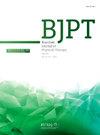Effectiveness of an app-delivered, self-management exercise program in public safety workers with chronic low back pain: a randomized controlled trial
IF 3.2
3区 医学
Q1 ORTHOPEDICS
引用次数: 0
Abstract
Background
Public safety workers (PSW), such as police officers and firefighters, face a high prevalence of chronic low back pain (LBP). Effective and accessible interventions are essential to improve their health and job performance.
Objective
To evaluate the effectiveness of a m-health-based core stability exercise self-management program combined with health education compared to m-health-based health education alone in PSW with chronic LBP.
Methods
Forty-seven PSW with chronic LBP were randomly assigned to receive a smartphone app-based self-managed exercise program (twice a week) plus health education (INT; n = 23) or health education alone (CON; n = 24) for eight weeks. Primary outcomes were pain intensity and disability at 8 weeks. PSW were assessed preintervention and 8 and 16 weeks after the randomization.
Results
Those in the INT group had a greater reduction in pain intensity (MD = -1.54; 95 %CI -2.95, -0.13) and disability (MD = -3.23; 95 %CI -5.51, -0.95) than those in the CON group at 8 weeks. Quality of life, self-efficacy, and anxiety improved for those in the INT group compared to those in the CON group at eight weeks. The treatment effects remained for disability, quality of life, and anxiety in the follow-up period of 16 weeks. No between-group differences were found for depression, stress, sleep quality, or neuromuscular outcomes.
Conclusion
A m-health-based core stability exercise self-management program combined with health education was more effective in reducing pain intensity, disability, and anxiety, as well as improving quality of life and self-efficacy, compared to m-health-based health education alone in PSW with chronic LBP.
应用程序提供的自我管理锻炼项目对慢性腰痛公共安全工作者的有效性:一项随机对照试验
公共安全工作者(PSW),如警察和消防员,面临着高患病率的慢性腰痛(LBP)。有效和可获得的干预措施对于改善她们的健康和工作表现至关重要。目的评价以移动健康为基础的核心稳定性锻炼自我管理项目与健康教育相结合对PSW合并慢性腰痛患者的治疗效果。方法47名患有慢性腰痛的PSW患者随机分配接受基于智能手机应用程序的自我管理锻炼计划(每周两次)和健康教育(INT;n = 23)或单独进行健康教育(CON;N = 24),持续8周。主要结局是疼痛强度和8周时的残疾。分别在干预前、随机化后8周和16周对PSW进行评估。结果INT组患者疼痛强度明显减轻(MD = -1.54;95% CI -2.95, -0.13)和残疾(MD = -3.23;(95% CI -5.51, -0.95)。8周时,与CON组相比,INT组的生活质量、自我效能和焦虑有所改善。在16周的随访期间,治疗效果在残疾、生活质量和焦虑方面保持不变。在抑郁、压力、睡眠质量或神经肌肉结果方面没有发现组间差异。结论基于移动健康的核心稳定性运动自我管理方案与健康教育相结合,在减轻慢性腰痛伴PSW患者的疼痛强度、残疾和焦虑、改善生活质量和自我效能感方面比单独进行移动健康健康教育更有效。
本文章由计算机程序翻译,如有差异,请以英文原文为准。
求助全文
约1分钟内获得全文
求助全文
来源期刊
CiteScore
6.10
自引率
8.80%
发文量
53
审稿时长
74 days
期刊介绍:
The Brazilian Journal of Physical Therapy (BJPT) is the official publication of the Brazilian Society of Physical Therapy Research and Graduate Studies (ABRAPG-Ft). It publishes original research articles on topics related to the areas of physical therapy and rehabilitation sciences, including clinical, basic or applied studies on the assessment, prevention, and treatment of movement disorders.

 求助内容:
求助内容: 应助结果提醒方式:
应助结果提醒方式:


